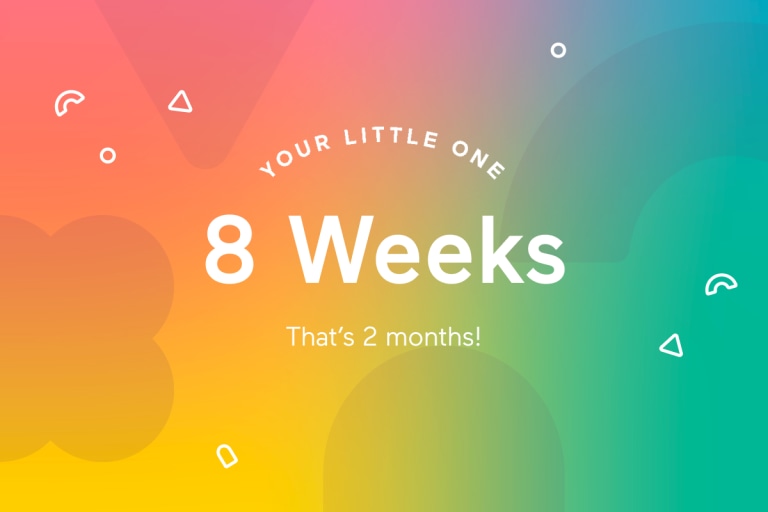
Your 8-Week-Old Baby
The scoop on supplementing formula, play time and why you should just hide your old jeans.

By Babylist Staff
Try putting baby down before they’re asleep.
When baby is starting to get sleepy (look for signs like rubbing eyes, yawning or looking away from you), get them ready for bed and place them in their crib or bassinet while they’re drowsy but not totally asleep yet. It may take awhile, but it will help them learn that they can fall asleep without mom, dad or a feeding, which is another tip. Try to break the habit of feeding your baby to sleep. This one can be hard, but it will help a lot in the long run!
Plan your first date night
How about a much-needed date night? Sure, it can be hard to leave your baby. But it’s really good to get out of the house and spend QT with your parnter (even if you spend half the time adoringly scrolling through baby photos on your phone).
For peace of mind, ask a family member or someone you trust to hold down the fort. Or book a sitter based on recommendations of neighborhood friends. Down the road you may use an online babysitting service like UrbanSitter or Care.com. But for your first night out, finding someone you know will ease those nerves.
If you’re breastfeeding, it may be helpful to head out after an evening feeding, so you’re more comfortable and your baby has a full tummy. Leave a bottle of pumped milk handy, too. If you’re using formula, be sure to prep the bottles or leave instructions.
Enjoy the break and the company, because just like Cinderella your carriage will turn into a pumpkin (well, more like a changing table at 3 a.m.).
8-week milestone: Heads up!
All that tummy time is paying off (woot woot!). Your baby is building head and neck strength and is even able to lift their noggin up and briefly look around the room. They also may be able to lift their head while lying on their back. Head control is a work in progress, so be sure to you’re still supporting your baby’s head when you’re holding them upright.
Self-care: Your body image after birth
You know those jeans hanging in your closet from before you got pregnant? Do yourself a favor: ignore them, donate them or make a patchwork quilt out of them. Whatever you do: remember that at two months postpartum, your body is still in recovery mode.
And you probably don’t look or feel like your pre-baby self. Your midsection may still be bigger and squishier, your hips may be wider. All of these changes are normal and expected. So be kind to yourself (you created a person, after all).
Treat yourself to some shopping (whether it’s from your couch or a nice solo trip to the mall). Buy a few new essentials that look good on your body now. You’ll feel happy to have new, flattering clothes to solve the “what should I wear?” conundrum at a time when you don’t need extra angst about your body. Accessories like a fun scarf or necklace are always your friend, since they freshen up any outfit—even a nursing tee that’s covered in spit-up.
How to choose the right formula
Whether you’re exclusively formula feeding or using it in addition to breastfeeding, there are lots of formula options on the market—all of which are regulated by the Food and Drug Administration and meet the same nutritional requirements.
There are three main types:
- Cow’s milk formula: the most prevalent type of formula, it’s fortified with iron and has been treated to make the protein more easily digestible.
- Soy formula: a vegan option that is only recommended by doctors in rare situations, such as when your baby is allergic to the protein in cow’s milk.
- Specialized formula: made for infants with specific disorders, diseases or who have particular needs such as premature babies or babies with a high risk of developing allergies.
Formula comes in three forms: powder that is mixed with water, liquid concentrate that is also mixed with water, and ready-to-feed bottles that don’t require mixing. The American Academy of Pediatrics has a detailed overview of formula ingredients.
While your baby will be your most helpful guide in figuring out which one to choose, here’s our list of the best formulas, compiled from research, as well as insight from thousands of Babylist families.
Try this: Playtime on the activity mat
Life is about to get really exciting for your little one. A small activity mat is the perfect spot to lay your tot down to stimulate the senses and practice tummy time.
These playmats come in a variety of shapes, sizes, and colors. They usually include interactive features like a mirror, crinkly materials and even soft toys that hang from overhead arches, play music or light up. When your baby develops better hand-eye coordination, they’ll start swatting at the toys, reaching and grabbing. For now, there will just be lots of happy lounging, gurgling and kicking.